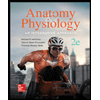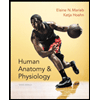
Human Anatomy & Physiology (11th Edition)
11th Edition
ISBN: 9780134580999
Author: Elaine N. Marieb, Katja N. Hoehn
Publisher: PEARSON
expand_more
expand_more
format_list_bulleted
Question
Increased venous return results in
a. increased stroke volume. c. decreased heart rate.
b. increased cardiac output. d. Both a and b are correct
Expert Solution
This question has been solved!
Explore an expertly crafted, step-by-step solution for a thorough understanding of key concepts.
This is a popular solution
Trending nowThis is a popular solution!
Step by stepSolved in 4 steps

Knowledge Booster
Similar questions
- During atrial fibrillation: O A. The EKG shows no discernable P wave. B. There is a noticeable decrease in the regularity of beating. O C. The ventricle continues to maintain cardiac output. O D. None of the above,arrow_forwardcardiac output will increase by a. decreased blood volume and decrease of heart contractility b. decreased heart rate and contractility c. increased venous return and increased heart contractility d. decreased peripheral resistance and decreased venous returnarrow_forwardVeins always contain unoxygenated blood and arteries always carry oxygenated blood. a. True b. Falsearrow_forward
- Which of the following is true regarding the conduction of electrical activity in the heart? Choose the best answer. a. Conduction through the AV node is relatively slow b. The wave of depolarization travels directly from the atrial muscle to the ventricular muscle c. The AV node determines heart rate in a healthy person d. 2 of the options are correct e. None of the options are correctarrow_forwardIt is generally accepted that a relatively low diastolic vascular pressure is more important than a relatively low systolic vascular pressure because: A. diastolic vascular pressure is the pressure that determines the length of diastole. B. diastolic vascular pressure directly determines stroke volume. C. diastolic vascular pressure ultimately determines and controls contractility. D. diastolic vascular pressure is a force the heart must compete with to open the aortic valve. E. None of the above is correct.arrow_forwarda. Only between cardiac cycles b. Ventricular diastole c. Ventricular systole d. Throughout the cardiac cyclearrow_forward
- Cardiac output is: A. The volume of blood pumped over a period of time. B. The stroke volume times the peripheral resistance. OC. Governed by the Nernst equation. D. All of the above. O E. None of the above.arrow_forwardAn increase in extracellular potassium levels can causea. an increase in stroke volume.b. an increase in force of contraction.c. a decrease in heart rate.d. Both a and b are correct.arrow_forwardThe Frank-Starling Law says that stroke volume a. is constant b. increases with deceased blood pressure c. increases with increased venous return d. increases with afterload e. increases with heart ratearrow_forward
- In the aorta, Select one: a. the resistance to blood flow is high, but velocity of blood flow is low. b. the velocity of blood flow is high, but blood pressure is low. c. velocity is diminished because the total cross-sectional area is small. d. the blood pressure and blood velocity are both high. e. the resistance to blood flow and the blood pressure are both low.arrow_forwardThe period of ejection: A. begins with closure of the AV-valves and ends with opening of the AV- valves B. begins with opening of the aortic valve and ends with closure of the aortic valve C. begins with the P-wave and ends with the QRS-complex D. begins with the QRS-complex and ends with the T-wavearrow_forwardDuring emergency situations, even if the nerves to the heart have been severed, the heart rate will: Select one: a. stay the same. b. decrease. c. increase. d. lead to hypotension.arrow_forward
arrow_back_ios
SEE MORE QUESTIONS
arrow_forward_ios
Recommended textbooks for you
 Human Anatomy & Physiology (11th Edition)Anatomy and PhysiologyISBN:9780134580999Author:Elaine N. Marieb, Katja N. HoehnPublisher:PEARSON
Human Anatomy & Physiology (11th Edition)Anatomy and PhysiologyISBN:9780134580999Author:Elaine N. Marieb, Katja N. HoehnPublisher:PEARSON Anatomy & PhysiologyAnatomy and PhysiologyISBN:9781259398629Author:McKinley, Michael P., O'loughlin, Valerie Dean, Bidle, Theresa StouterPublisher:Mcgraw Hill Education,
Anatomy & PhysiologyAnatomy and PhysiologyISBN:9781259398629Author:McKinley, Michael P., O'loughlin, Valerie Dean, Bidle, Theresa StouterPublisher:Mcgraw Hill Education, Human AnatomyAnatomy and PhysiologyISBN:9780135168059Author:Marieb, Elaine Nicpon, Brady, Patricia, Mallatt, JonPublisher:Pearson Education, Inc.,
Human AnatomyAnatomy and PhysiologyISBN:9780135168059Author:Marieb, Elaine Nicpon, Brady, Patricia, Mallatt, JonPublisher:Pearson Education, Inc., Anatomy & Physiology: An Integrative ApproachAnatomy and PhysiologyISBN:9780078024283Author:Michael McKinley Dr., Valerie O'Loughlin, Theresa BidlePublisher:McGraw-Hill Education
Anatomy & Physiology: An Integrative ApproachAnatomy and PhysiologyISBN:9780078024283Author:Michael McKinley Dr., Valerie O'Loughlin, Theresa BidlePublisher:McGraw-Hill Education Human Anatomy & Physiology (Marieb, Human Anatomy...Anatomy and PhysiologyISBN:9780321927040Author:Elaine N. Marieb, Katja HoehnPublisher:PEARSON
Human Anatomy & Physiology (Marieb, Human Anatomy...Anatomy and PhysiologyISBN:9780321927040Author:Elaine N. Marieb, Katja HoehnPublisher:PEARSON

Human Anatomy & Physiology (11th Edition)
Anatomy and Physiology
ISBN:9780134580999
Author:Elaine N. Marieb, Katja N. Hoehn
Publisher:PEARSON

Anatomy & Physiology
Anatomy and Physiology
ISBN:9781259398629
Author:McKinley, Michael P., O'loughlin, Valerie Dean, Bidle, Theresa Stouter
Publisher:Mcgraw Hill Education,

Human Anatomy
Anatomy and Physiology
ISBN:9780135168059
Author:Marieb, Elaine Nicpon, Brady, Patricia, Mallatt, Jon
Publisher:Pearson Education, Inc.,

Anatomy & Physiology: An Integrative Approach
Anatomy and Physiology
ISBN:9780078024283
Author:Michael McKinley Dr., Valerie O'Loughlin, Theresa Bidle
Publisher:McGraw-Hill Education

Human Anatomy & Physiology (Marieb, Human Anatomy...
Anatomy and Physiology
ISBN:9780321927040
Author:Elaine N. Marieb, Katja Hoehn
Publisher:PEARSON